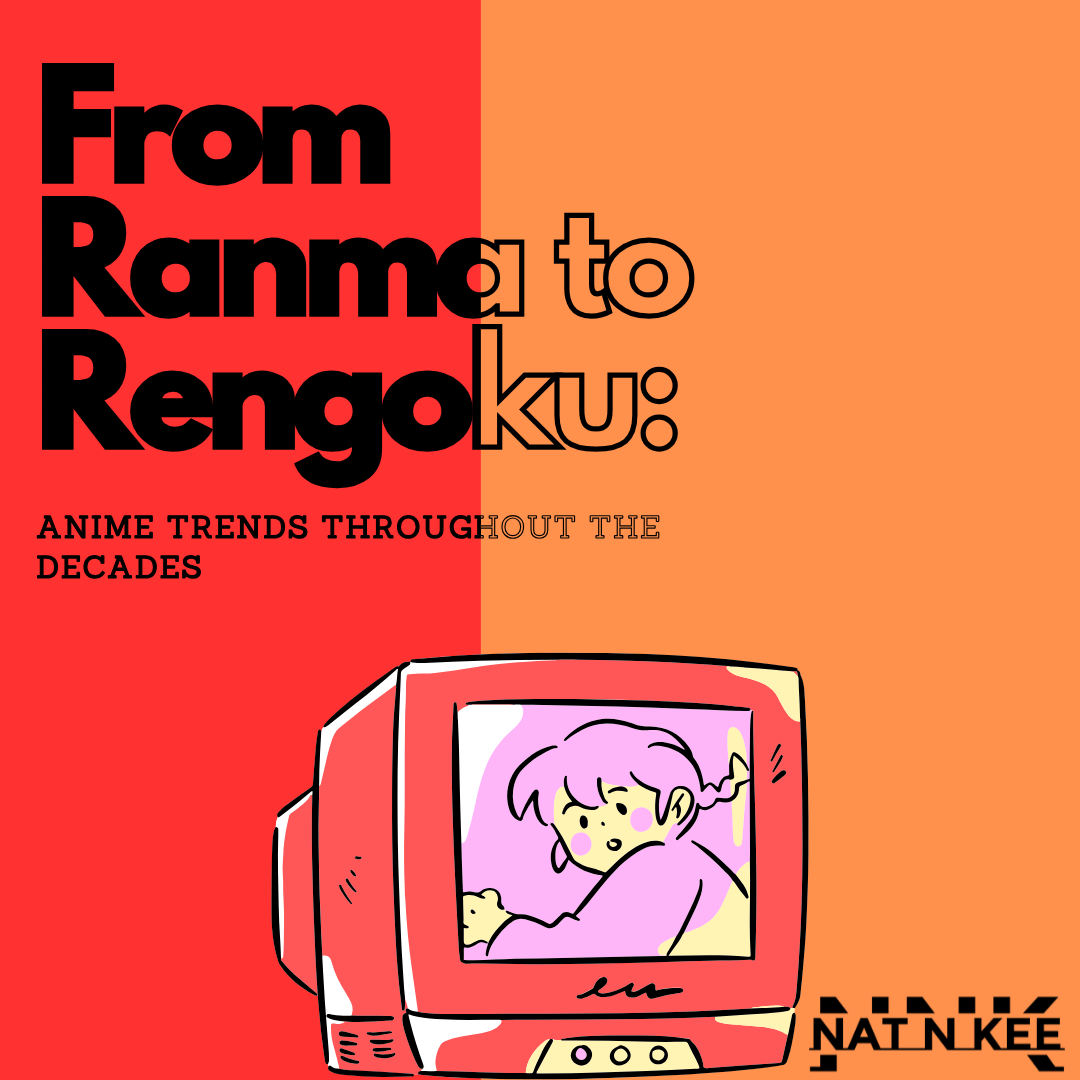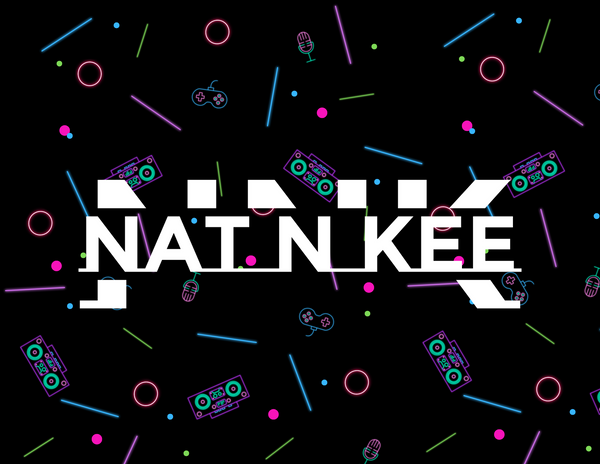
From Ranma to Rengoku: Anime Trends Throughout the Decades
Compartir
Strap in, this is gonna be a big one...
Anime has evolved into a global phenomenon, captivating audiences with its unique storytelling and stunning visuals. From its humble beginnings in Japan, anime has steadily gained popularity worldwide, expanding its reach across generations and cultures. Today, anime boasts a massive global following, with millions of fans eagerly awaiting the latest releases. The anime industry has witnessed wicked growth, with increasing revenue and a diverse range of genres catering to various tastes. As anime continues to evolve and adapt to changing trends, its impact on popular culture is undeniable.
Statistics:
- Viewership: In 2021, 36% of viewers worldwide enjoyed watching anime. (Poggers)
- Demand: Anime ranks as the 3rd most in-demand subgenre worldwide, with a demand share of 5.5%. (Poggers)
- Market Growth: The global anime market size was estimated at USD 31.23 billion in 2023 and is anticipated to grow at a compound annual growth rate (CAGR) of 9.8% from 2024 to 2030. (Grand View Research)
These statistics highlight anime's significant global reach and influence. With its diverse genres, this subgenre of media continues to attract new fans and contribute to its enduring popularity.
Decades of Anime Evolution:
1960s-1970s: The Early Years
Without aging yourself, try to think of the oldest anime you've ever seen. A lot of Americans can say that Shonen series, like "Dragon BalI" and "Naruto", were their first glances into the world of anime. It came on late at night on "Toonami", likely after an American cartoon that we all loved went off. Out of pure curiously, a few of us kept watching. I can recall "Bleach" being one of the first shows on the schedule when "Toonami" started and thought it was really weird, but I'm so glad younger me kept watching.

(Toonami Tom from r/nostaglia)
These series debuted in the late 80s to early 2000s, so there must have been something that came before it, right? Let me save you the research: yes, yes there was. The 60s and 70s were pivotal years for anime, with a surge in new forms of storytelling and groundbreaking animation techniques. Some of the most iconic series from this era explored themes that still resonate with audiences today. Here's a few series that you might of heard of from the Early Years:
- Astro Boy (1963): This classic series follows the adventures of a young robot boy created by a brilliant scientist. Themes: Humanity, artificial intelligence, and the ethical implications of technological advancement.
- Kimba the White Lion (1965): Set in the African savannah, this series tells the story of a young white lion who must protect his pride. Themes: Animal rights, environmental conservation, and the circle of life.
- Mazinger Z (1972): A giant robot piloted by a young boy defends the Earth from evil forces. Themes: Superheroes, mecha, and the battle between good and evil.
- Space Battleship Yamato (1974): A crew of humans aboard a powerful spaceship fights to save Earth from an alien threat. Themes: Space exploration, environmentalism, and the importance of hope and perseverance.
Just from these few, we can see a common set of themes from this generation. Science Fiction, Superhero, Adventure, and Historical Drama genres achieved critical acclaim during this time. What was going on in 1960s Japan that caused this love and fascination for science, powers, and the unknown? This was post-war Japan. The popularity of these genres reflected the aspirations, cultural values, and social concerns of the time. They provided entertainment, escapism, and a platform for social commentary, making them enduringly popular with audiences of all ages.
1980s: The Golden Age
Let's steam-roll 10 years ahead. The 80s. What a time (I was not born yet) to be alive for some. The 1980s marked a period of significant economic growth and cultural transformation in Japan. The country experienced a "Bubble Economy," leading to rapid economic expansion and technological innovation. Japan emerged as a global leader in electronics and automotive industries, producing iconic products like the Walkman, VCR, and high-quality cars.

A legit dinosaur. The Sony Walkman from CTV News.
Culturally, the 1980s were a golden age for anime and manga, with series like "Dragon Ball Z", "Akira", and "Ranma 1/2" gaining worldwide popularity. Japanese fashion and music also gained international recognition. They saw the rise of Harajuku-style and J-pop music. While the economic boom eventually slowed down, the cultural impact and technological advancements of the 1980s continue to shape Japan's identity and influence global culture.
In addition, some of the most legendary anime series debuted around this time. The 80s had a surge in interest in cyberpunk and dystopian futures and led to some amazing media being born. "Mobile Suit Gundam", "Akira" and "Ghost in the Shell" rose up to be cultural pillars for Japan, and their legacies can still be seen everywhere. Everywhere. At this point, anime was gradually becoming the global phenomena it is today. It was no longer Japan's not-so-little-secret.
1990s: The Magical Girl Era
The early part of the 1990s saw the bursting of the "bubble economy," which led to a prolonged economic downturn known as the "Lost Decade." This period was characterized by sluggish economic growth, deflation, and a decline in the standard of living for many Japanese people. Despite the economic challenges, the 1990s also saw significant cultural developments. Anime and manga continued to gain popularity both domestically and internationally, with iconic series like "Neon Genesis Evangelion" and "Sailor Moon" drawing in audiences worldwide. The blooming of the internet and video games turned this into a global feel-good epidemic.

Megan thee Stallion as Sailor Moon from Show News Today.
Many of the 90s magical girl anime evoked feelings of nostalgia for childhood and simpler times. The themes of friendship, love, and overcoming challenges resonated with both children and adults. Young women felt empowered watching these shows, and everyone else surely fell in love with the delicate characters who transformed into beautiful, powerful warriors.
I will admit, the magical girl genre never did it for me as a 90s baby. It just wasn't my cup of tea. My magical girls were probably the "Powerpuff Girls", but that doesn't mean this genre wasn't popular in the states. Interest in the "Sailor Moon" series has spiked recently due to the reviving of the series with "Sailor Moon Crystal", and celebrities like Megan thee Stallion using it as inspiration for her cosplay and a hit song.
2000s: The Shōnen Boom
Fighting, adventure, and coming-of-age. That was the concept of nearly all of the early 2000s anime and manga. At this point, "Toonami" was in full swing and some of the best of the best was finally being aired in the States.

The Big Three from GameRant.
Japan, however, was still feeling the affects of the "Lost Decade" and youth unemployment was on the rise. Nevertheless, Weekly Shonen Jump was at its peak at this time. The magazine saw its Shonen Boom, and it popularized series like, "Naruto", "Bleach", and "One Piece". Some say the hike in NEETs (Neither Employed, Educated, or Training) and otaku assisted in this golden era for Jump, and it is likely possible. If that is true, the "Big Three" couldn't have come out at a better time. Their influences were also seen in another craze that was on the rise: fashion subcultures. Cosplay skyrocketed during the Shonen Boom, and many fans wanted to, at least just for a moment, embody their anime heroes.
2010s-Present: The Modern Era
If you open Netflix, Hulu, or Amazon Prime Video, you'll notice that each platform has their own "originals". A "Netflix Original", "Hulu Original", and so on. Swiping through these categories, you'll likely find many anime in the top spots.
Prior to the 2010s, before streaming was a thing, you had very few options to legally watch non-mainstream anime. For many young Americans, it was still pretty niche, so you either pirated it, settled with what was on "Toonami", or you went to Blockbuster. (Remember Blockbuster?!) While websites like Crunchyroll existed, you had to wait days, sometimes, to get caught up on your favorite shows (Crunchyroll is a whole can of worms we are not getting into... ) and often cycled through series whose seasons were already completed. In 2007, however, Netflix came on the scene as a streaming service, but you weren't going there for anime.
Luckily, the 2010s was another decade chock full of visually stunning anime. New editing and animation techniques created new worlds in the best way imaginable. This era brought us "Attack on Titan", "My Hero Academia", "Demon Slayer", and a boatload of isekai anime, a genre many had never heard of before. These obscure series with a sentence for a name, sprung up left and right within recent years. Modern isekai (which roughly means "another world") anime include:
-
Reborn as a Vending Machine: I Now Wander the Dungeon

- Saving 80,000 Gold in Another World for My Retirement
- That Time I Got Reincarnated as a Slime
- Mushoku Tensei: Jobless Reincarnation
- Uncle From Another World
- Parallel World Pharmacy
- The Devil is a Part-timer
- No Game No Life
- Sword Art Online
- Frieren
and many others that are a mouthful. While the genre has been used since ancient times in Japan for folktales and early literature, it's really interesting to see its modern development through anime. (Image shown from iMDB)
Okay.
We did it.
From its humble beginnings to its global dominance, anime has no doubt become a cultural phenomenon. By exploring the historical and cultural context of each era, we can better understand the evolution of this beloved medium. My academic background in Japanese language and anthropology has allowed me to delve deep into the heart of anime, uncovering the intricate connections between art, history, and society.
Where do you think anime will go next? What themes will the next decade embrace and how will history shape it? Give us your inferences below or over on the Instagram/Pinterest post announcing this article. We can't wait to hear with you all come up with!
P.S. If you ever find the time, I highly recommend going back to the oldies and comparing it to what's airing today. You can also find bookmarks for a lot of the anime/manga discussed in our Manga Bookmarks collection!
-Nat
